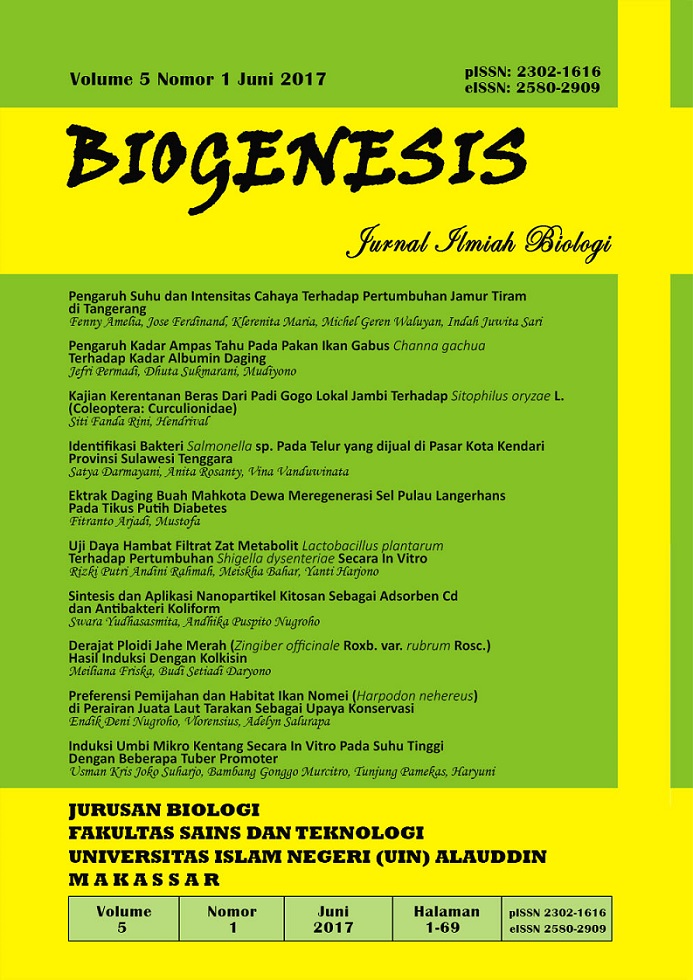Pengaruh Kadar Ampas Tahu Pada Pakan Ikan Gabus Channa gachua Terhadap Kadar Albumin Daging
Abstract
The need for medical albumin is currently at 91%, which is relatively expensive price of albumin causes many people to switch to a cheap source of albumin of snakehead fish. This led to the exploitation of snakehead fish on a large scale so that the fish populations in natural will experience deterioration. Until now, the snakehead fish has not been cultivated by farmers because the fish is not a commodity featured and high production costs of the feed sector. Meanwhile, the potential for additional material feed nutrients are available quite easily and cheaply from the waste tofu. Utilization of bagasse as a mixture of snakehead fish feed can be an alternative to reduce the cost of the feed without reducing the quality of fish in terms of content snakehead fish albumin. In addition, tofu is used as dietary supplement of snakehead fish is expected to reduce the rate of environmental pollution caused by waste agricultural products. The method was used in this research is experimental. Snakehead fish is reared for 17 days with one control and four treatments of feed that is, commercial feed with a mixture of 20%, 40%, 50% and 70% tofu waste. After 17 days of snakehead fish from each treatment were analyzed its albumin levels. The data analysis using regression and correlation to determine the relationship between the treatments of feed against the observed variables. Results of regression and correlation analysis shows that administration of tofu waste in different concentrations has no effect on the feed exhibited significantly to weight and body length of the fish, the oxygen content, pH, water temperature, weight of the test sample and albumin levels in fish flesh. But the determinant of constant value shows that there is one variable that have relevance to the treatment. Based on Pearson correlation test, it is known that high levels of tofu waste given to the feed associated with increased levels of albumin catfish at each treatment. The highest levels of snakehead fish albumin is 4,835 g/100 g of fish meat on the treatment of 70% tofu waste out on feed, while the lowest levels of albumin is contained in the 2286 control treatment that is 0% tofu waste to the snakehead feed.Copyright (c) 2017 Jefri Permadi, Dhuta Sukmarani, Mudiyono Mudiyono

This work is licensed under a Creative Commons Attribution 4.0 International License.
COPYRIGHT AND LICENSE STATEMENT
COPYRIGHT
Biogenesis: Jurnal Ilmiah Biologi is published under the terms of the Creative Commons Attribution license. Authors hold the copyright and retain publishing rights without restriction to their work. Users may read, download, copy, distribute, and print the work in any medium, provided the original work is properly cited.
LICENSE TO PUBLISH
1. License
The use of the article will be governed by the Creative Commons Attribution license as currently displayed on http://creativecommons.org/licenses/by/4.0.
2. Author’s Warranties
The author warrants that the article is original, written by stated author/s, has not been published before, contains no unlawful statements, does not infringe the rights of others, is subject to copyright that is vested exclusively in the author and free of any third party rights, and that any necessary written permissions to quote from other sources have been obtained by the author(s).
3. User Rights
Under the Creative Commons Attribution license, the users are free to download, reuse, reprint, modify, distribute and/or copy the content for any purpose, even commercially, as long as the original authors and source are cited. No permission is required from the authors or the publishers.
4. Co-Authorship
If the article was prepared jointly with other authors, the corresponding author warrants that he/she has been authorized by all co-authors, and agrees to inform his/her co-authors of the terms of this statement.
5. Miscellaneous
Biogenesis: Jurnal Ilmiah Biologi may conform the article to a style of punctuation, spelling, capitalization, and usage that it deems appropriate. The author acknowledges that the article may be published so that it will be publicly accessible and such access will be free of charge for the readers.


